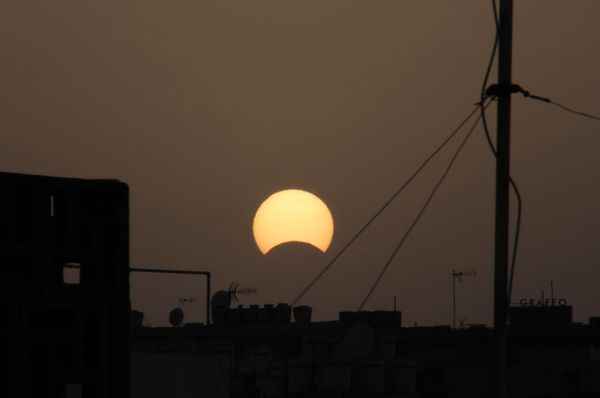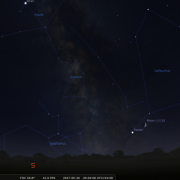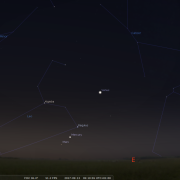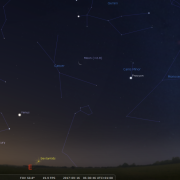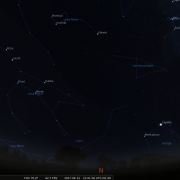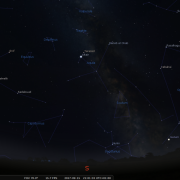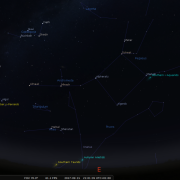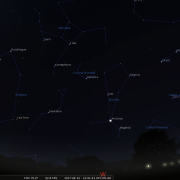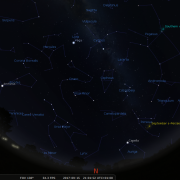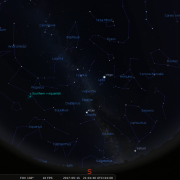
Welcome to the WDAS monthly newsletter for September 2017: a digest of the month's latest contributions to our website. Below you'll find Society News, Sky Notes and In-Focus articles printed in full. There's also future events, and trailers for other articles which appear in full on the website - just a click away!
Society News
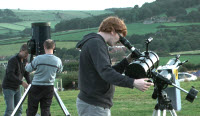 Tonight (Sept 1st) is Hooks House night, so if you read this in time and are planning on coming over, weather permitting we aim to be there for around 20:00h. The Moon will be just after First Quarter, Saturn will still be quite well placed, so there should be something on offer for all (weather permitting) and if so it should be a cracking evening.
Tonight (Sept 1st) is Hooks House night, so if you read this in time and are planning on coming over, weather permitting we aim to be there for around 20:00h. The Moon will be just after First Quarter, Saturn will still be quite well placed, so there should be something on offer for all (weather permitting) and if so it should be a cracking evening.
Our annual pilgrimage to Westerdale will take place on Sept 15th. As it’s starting to get dark earlier, it is planned to be at the village hall by 19:45h, allowing a little time to set up the scopes. We shall be setting off from Mark’s house on Laburnum Grove for 19:15h. We always receive a very friendly welcome and I’m sure John Randles will be on hand to muster the locals. Let us hope the weather is similar to the previous few years, when fine clear skies have been the order.
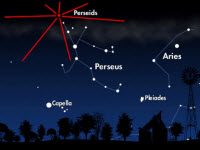
Image: TimeAndDate.com
Unless you had stopped up all night, the chances of spotting any shooting stars from our neighbourhood were pretty negligible. The waning gibbous moon would have drowned out most, however cloud cover obscured all! Apparently it did break up sometime in the early morning hours, allowing moonlight to drown out any late meteors. Super!
So, what did Mother Nature have in store for this year’s Regatta – the usual mixture of inclement dross, incorrect forecasts and a blank white disk to look at for hours on end! Well, at least any likely showers would fall on a new gazebo, purchased just a few days prior. The old one requires major (but not insurmountable) work to rectify various issues – particularly with the strut frame work – so we thought a new one would be the better option for now.
It was unpacked and erected on the Saturday afternoon, an hour before our solar event was due to start. Saturday, although actually quite sunny, was let down by a nagging breeze, met office speak for a blustery gale at least that’s what it felt like sometimes. Still, if you can erect a gazebo in conditions like that, it should be a doddle in calm weather. Keith and Mark battled on and surprisingly had the thing up in less than 15minutes, pegged and tethered down.
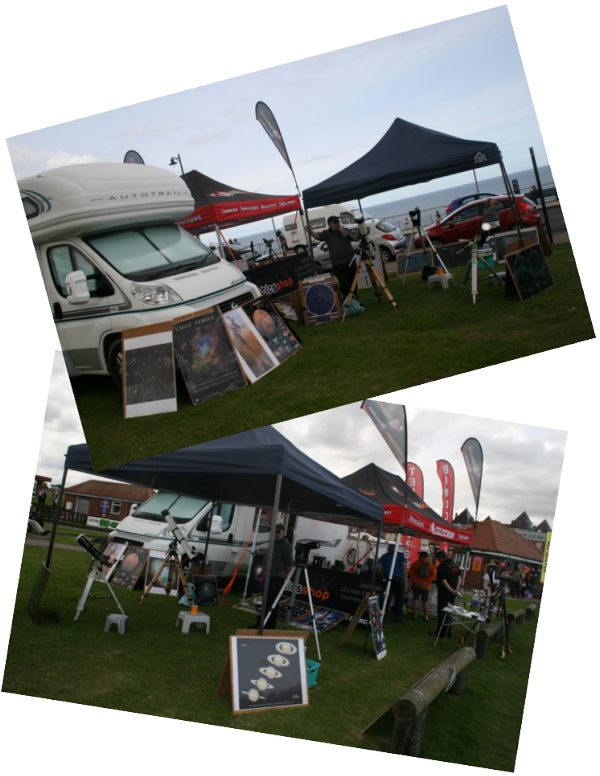
Our colleague Marcus from Grover Optics was once again pitched adjacent, with the birds of prey eyeing up the un wary on the other side.
Having set up ‘shop’ with scopes and posters etc it was time to see what, if anything was on the sun. Wow! Not a blank, disk, but a decent grouping of sunspots occupying the equatorial region, a fine sight indeed and one that people could appreciate for once.
Clouds, people and our flyers came and went, the A4 flyers gaining their wings during a particularly blustery period, plastering cars, bikes, people, babies alike across in crescent garden. Fortunately people ran, fetched and retrieved (a bit like Marcus’s new Border collie) and within 5 minutes all the literature was securely nailed down to the table.
Saturday evening was meant to be the clear night... it wasn’t, but strangely all was not lost with a clearing to the SW allowing views of Saturn, much to the delight of the ‘party goers. Eventually the cloud cover did fragment, allowing observations of a few deep sky objects, the LX having its first run out this season.
Sunday afternoon – was much calmer, and erecting the gazebo was indeed a doddle, but the high hazy cloud robbed us of the clarity of the solar disk we had enjoyed on the Saturday.
The forecast was not encouraging for the Sunday evening – cloud cover would continue to build, preventing any observations whatsoever. Well, cloud did build up, slowing marching across the sky. Then the subsiding breeze swung round to the ESE and lo and behold the cloud fragmented and marched off again. So having expected to preside over a ‘cloud party’ the LX and several members were called into action for what turned out to be a half decent event.
Mark ventured up to assist Marcus on the Monday afternoon, and tried a little solar viewing with one of his spotting scopes and our ETX solar filter. The sunspot group was evolving nicely. Tentative plans had been made to train a scope on the setting sun that evening to observe the 4% partial solar eclipse, but in the end thicker cloud prevented any chance of doing this, but at least we could enjoy the NASA on line streaming of the total eclipse tracking across the US. So, Regatta, in summary 7 out of 10 I guess.
Images: taken by Mark - 20-Aug-2017, 12:15h.
Astronomy fever gripped America in August, where millions were treated to a total solar eclipse. And WDAS was also invited to join in, by a website visitor from Whitby (Ontario), wondering what events we had planned.
Although Regatta Monday was laid on in celebration, or otherwise, the 5% eclipse in Whitby (North Yorkshire) was less exciting to behold, particularly as it was hidden from view by thick cloud.
However Andi and Héctor's friend and colleague, Javier, captured this imagen evocadora from his home in Gran Canaria. Thanks to Javier for letting us publish it here. (Click photo for larger image.)
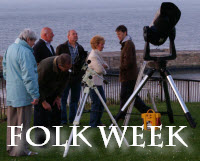 Unusually for Folk Week it didn’t rain every single day, in fact Wednesday (Egton show day) was the only bad day... and it was bad, and dark, very dark, sort of total eclipse dark with apocalyptic rain for several hours. Prospects for the evening star party therefore looked encouraging.
Unusually for Folk Week it didn’t rain every single day, in fact Wednesday (Egton show day) was the only bad day... and it was bad, and dark, very dark, sort of total eclipse dark with apocalyptic rain for several hours. Prospects for the evening star party therefore looked encouraging.
Come the evening, the day’s storm was just a memory and clear skies were now overhead. Keith, Lee and Mark made the most of them. Saturn was the main target... appearing a little higher than anticipated and not behind the Royal Hotel as feared, at least not for a while anyway. The image was surprisingly steady, and caused much excitement, especially when Titan was pointed out. Once Saturn was hidden, our favourite deep sky objects were centred in the eyepiece, the transparent conditions allowing great views, much appreciated by the visiting host.
Mark did a solo party the following evening, although conditions were not as clear with slightly milky skies, people were still impressed with the views of Saturn, deep sky objects were though harder to appreciate.
Given that this event was organised for a bank holiday weekend, it was pleasantly surprising to plan for the evening with a high degree of confidence of clear skies. Mark, Andi and Keith made the journey over to Northcliffe holiday park at Hawsker, (Andi and Keith checking out Seaview park en-route), three scopes packed including the LX 200. Once we had negotiated the bollard and gate (don’t ask) leading to the football field, the instruments were set up and we prepared for a great evening’s observation.
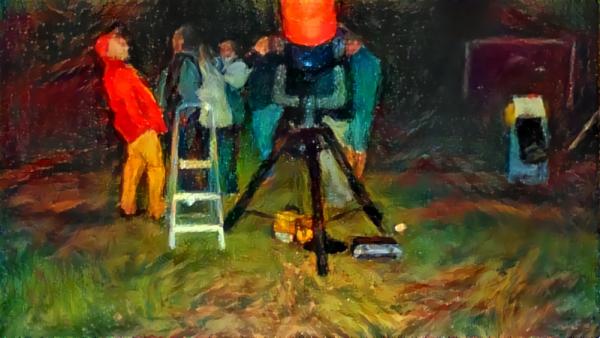
The location was great for our purposes – clear aspects, flat ground and plenty of it so that we could demonstrate the scaled solar system. This played well with the attendee’s...estimated to be around 40.
The crescent moon was our first port of call, shortly followed by Saturn, which was unhindered from obstructions. Both objects drew gasps. As twilight deepened, it was obvious that ‘seeing’ would be very good for a coastal location. Attention turned to deep sky objects, The Ring nebula (M57) looked magnificent, brighter, with so much more detail present. The same was true for all the objects targeted, making it a real joy for people experiencing their first views of such deep sky wonders.
Mark conducted a tour of the night sky, borrowing Keith’s laser pointer for the purpose having stupidly left his own at home...Dohh!
With conditions fully dark, the Milky Way was clearly visible to the naked eye, arcing across the sky from NE to SW.
It has to be said it was a pleasure to be out under the stars, an experience shared by all present and stayed on. By 23:00h it was time to pack up – thank our hosts Andy and Sophie who had organised the event at the site. We all expressed a desire to host another one – making it a regular event perhaps. Watch this space.
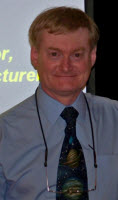 Having finally made contact with Paul, we have pencilled in a date for his postponed talk. Unfortunately it will be 2018 before Paul can make it as he running a WEA course until March of 2018. He then only had a few available dates on a Tuesday left, so we have plumped for Tuesday May 8th. We are assuming that all being well the venue will be the college hall, but we will confirm this and the presentation topic in due course.
Having finally made contact with Paul, we have pencilled in a date for his postponed talk. Unfortunately it will be 2018 before Paul can make it as he running a WEA course until March of 2018. He then only had a few available dates on a Tuesday left, so we have plumped for Tuesday May 8th. We are assuming that all being well the venue will be the college hall, but we will confirm this and the presentation topic in due course.
Sky Notes
In this month's Sky Notes:
Planetary Skylights
 Jupiter lingers in the evening twilight very low in the Northwest, but essentially from midmonth onwards it will become increasingly difficult to observe.
Jupiter lingers in the evening twilight very low in the Northwest, but essentially from midmonth onwards it will become increasingly difficult to observe.

 Saturn is also drawing closer to the west horizon, but is at least readily visible all month low to the Southwest. If you plan to observe Saturn using a telescope, do so as soon as it becomes dark enough to spot. Look for a conspicuous pearly white ‘star’ in that direction. A modest telescope will reveal the ring system, which is orientated favourably at present; but due to low altitude patience is required at the eyepiece, waiting for those tantalising steady seeing moments. Our Moon lies nearby on the 26th.
Saturn is also drawing closer to the west horizon, but is at least readily visible all month low to the Southwest. If you plan to observe Saturn using a telescope, do so as soon as it becomes dark enough to spot. Look for a conspicuous pearly white ‘star’ in that direction. A modest telescope will reveal the ring system, which is orientated favourably at present; but due to low altitude patience is required at the eyepiece, waiting for those tantalising steady seeing moments. Our Moon lies nearby on the 26th.
 Venus is visible in the pre-dawn sky located low in the ENE from around 03:00h. The brilliant ‘morning star’ should be unmistakeable. View on the 1st around 05:00h when Venus is in conjunction with M44 (the ‘Beehive’) in Cancer, lying just below the star cluster. Later in the month Venus slides toward Regulus – chief star of Leo, the crescent moon joining them on the 18th.
Venus is visible in the pre-dawn sky located low in the ENE from around 03:00h. The brilliant ‘morning star’ should be unmistakeable. View on the 1st around 05:00h when Venus is in conjunction with M44 (the ‘Beehive’) in Cancer, lying just below the star cluster. Later in the month Venus slides toward Regulus – chief star of Leo, the crescent moon joining them on the 18th.

 Both Mars and Mercury will also be visible in the dawn sky over in the east. Mercury actually has its best morning apparition of the year gaining nearly 10 degrees above the horizon by September 12th. Start viewing from the 5th around 05:30h. It will be joined by Mars as the red planet moves out of the glare of the sun and up into the dawn sky during September. On the 5th Mars lies upper left of Regulus, with Mercury off to the right, but by the 10th both planets lie below Regulus. All will be in the same 7 x 50 binocular field of view.
Both Mars and Mercury will also be visible in the dawn sky over in the east. Mercury actually has its best morning apparition of the year gaining nearly 10 degrees above the horizon by September 12th. Start viewing from the 5th around 05:30h. It will be joined by Mars as the red planet moves out of the glare of the sun and up into the dawn sky during September. On the 5th Mars lies upper left of Regulus, with Mercury off to the right, but by the 10th both planets lie below Regulus. All will be in the same 7 x 50 binocular field of view.
Mars and Mercury are closest on the 16th and 17th, the two planets crossing paths over those dates. Mercury will start the month quite faint, brightening as September rolls by, becoming conspicuous to the eye by the 20th . Mars will have an orange tinge, and appear slightly less bright than Regulus.
Meteors & Comets

There are no major noteworthy meteor showers in September; however you may spot a few Piscids which have two peaks: the 8th and the 21st. Rates are low, only 6 or 7 per hour at best. As with all meteor showers early morning viewing will be best.
September 2017 Sky Charts
|
Looking North
Mid-September - 21:00h |
Looking South |
|
Looking East
Mid-September - 21:00h |
Looking West
Mid-September - 21:00h |
| Northern Aspect Mid-September - 21:00h |
Southern Aspect Mid-September - 21:00h |
Additional Image Credits:
- Planets and Comets where not otherwise mentioned: NASA
- Sky Charts: Stellarium Software
In-Focus
The origin and true identity of this constellation was lost even to the ancient Greeks, who knew the figure as Engonasi, which literally means ‘the kneeling one’. It was Eratosthenes who identified the figure as Heracles (the Greek name for Hercules) in the 3rd century BC.
Mythology
In Greek mythology Hercules was the illicit son of Zeus and the beautiful mortal women, Alcmene, whom Zeus visited in the guise of her husband, Amphitryon. The infant Hercules became immortal, after he suckled milk from the goddess Hera, Zeus’s real wife, who was asleep at the time. Once Hera learned of the truth, she was outraged and vowed to make Hercules' life as uncomfortable as possible.
Under Hera’s evil spell Hercules killed his own children in a fit of madness, and in an effort to atone for his dreadful deed when sanity returned, was ordered by the Oracle at Delphi to serve Eurystheus, King of Mycenae, for 12 years. In total Eurystheus set him a series of 12 tasks that are called 'the Labours of Heracles'.

The Twelve Labours of Hercules
The first was to kill a lion that was terrorising the land around the City of Nemea. This lion had a hide that was impervious to any weapon, so Heracles strangled it to death. The Nemean lion is identified with the constellation Leo.
 His second labour was to kill the multi-headed monster Hydra, a pet raised by Hera from birth. The monster inhabited a swamp near the town of Lerna, and as Hercules found out, could regenerate heads – as one was cut off two would replace it. Hercules called for help from his charioteer, Iolaus, who helped cauterise the head stumps before they could regenerate. On seeing that her pet monster was in trouble, Hera sent a giant crab to attack Hercules whilst fighting the Hydra, but the crustacean was crushed by Hercules, stamping on the crab. Hercules dipped his arrows in the Hydra’s poisonous blood, an action that would eventually be his undoing. A distraught Hera placed both the crab (Cancer) and the Hydra in the heavens.
His second labour was to kill the multi-headed monster Hydra, a pet raised by Hera from birth. The monster inhabited a swamp near the town of Lerna, and as Hercules found out, could regenerate heads – as one was cut off two would replace it. Hercules called for help from his charioteer, Iolaus, who helped cauterise the head stumps before they could regenerate. On seeing that her pet monster was in trouble, Hera sent a giant crab to attack Hercules whilst fighting the Hydra, but the crustacean was crushed by Hercules, stamping on the crab. Hercules dipped his arrows in the Hydra’s poisonous blood, an action that would eventually be his undoing. A distraught Hera placed both the crab (Cancer) and the Hydra in the heavens.
For his next two labours, Hercules was ordered to catch elusive animals: a deer with golden horns, and a ferocious boar. For his fifth labour Hercules cleaned the dung filled stables of King Augeias of Elis in one day by diverting two rivers. For his sixth task he dispersed a flock of marauding birds with arrow-like feathers, the survivors of which flew to the Black Sea, where they subsequently attacked Jason and the Argonauts.
Hercules then sailed to Crete to capture a fire-breathing bull that was ravaging the land, before ensnaring the flesh-eating horses of King Diomedes of Thrace and then delivering the Belt of Hippolyte, Queen of the Amazons to Eurystheus for his ninth task.
For his 10th task Hercules was sent to steal the cattle of Geryon, a triple-bodied monster who ruled the Island of Erytheia, far to the west. En-route, Hercules set up the columns at the Straits of Gibraltar called the Pillars of Heracles. The image of which is depicted on the famous Spanish pieces of eight coins. Geryon with dispatched with a single arrow that pierced all three bodies from the side.
Refusing to release Hercules from his service, because he had received help killing the Hydra, Eurystheus set him two additional tasks. The first was to steal the golden apples from the garden of Hera on the slopes of Mount Atlas, guarded by the Dragon Ladon. Hercules dispatched Ladon with a well-aimed arrow, and then asked Atlas who was stood nearby holding up the sky, to pick and fetch the apples - Hercules temporarily performing Atlas’s job. A furious Hera set the dragon in the sky as the constellation Draco.
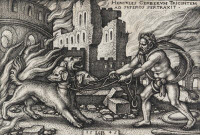 The twelfth labour, the most daunting of all, took him down to the gates of the Underworld to fetch Cerberus, the three-headed watchdog. Cerberus had the tail of a dragon and a snake covered back. Hercules utilised the pelt of the Nemean lion to protect himself, whilst wrestling with Ceberus, dragging the slavering dog to the startled King Eurystheus, who never expected to see Hercules alive. With all his labours completed, Eurystheus had no option but to make Hercules a free man again.
The twelfth labour, the most daunting of all, took him down to the gates of the Underworld to fetch Cerberus, the three-headed watchdog. Cerberus had the tail of a dragon and a snake covered back. Hercules utilised the pelt of the Nemean lion to protect himself, whilst wrestling with Ceberus, dragging the slavering dog to the startled King Eurystheus, who never expected to see Hercules alive. With all his labours completed, Eurystheus had no option but to make Hercules a free man again.
After his labours, Heracles married Deianeira, the young and beautiful daughter of King Oeneus. Whilst travelling, Hercules and Deianeira reached the river Evenus, across which where the centaur, Nessus, ferried passengers. The centaur, aroused by her beauty, tried to ravish her and Hercules shot him with an arrow tipped with the Hydra’s poison. The dying centaur offered Deianeira some of his blood, deceitfully claiming that it would act as a love charm. She accepted, keeping it safe until much later when she suspected Hercules was ‘seeing’ another woman. Deianeira gave Hercules a shirt on which she had smeared the blood of the dying Nessus, hoping to win back his affection. When Hercules put it on, the Hydra’s poison began to burn his flesh to the bone. Realising there was no release from the pain, Hercules built himself a funeral pyre on Mount Oeta, laid down on it and as the flames burned up the mortal part of him, the immortal part ascended to join the gods on Mount Olympus, where Zeus, turned placed him in the sky.

The Constellation
Considering Hercules is regarded as perhaps the greatest of Greek and Roman heroes, it is surprising that the constellation, although the 5th largest in the sky, is rather inconspicuous and ill defined, apart from the ‘keystone’ asterism. It contains no 1st or 2nd magnitude stars, but it does contain some fine deep sky objects –in particular M13. The more important or brighter star members are as follows.

Constellation of Hercules
Alpha Herculis or Rasalgethi, from the Arabic meaning ‘the kneeler’s head’, is a red giant star that varies from third to fourth magnitude. It is actually a triple star system some 359 light-years distant, the main components of which can be separated in amateur telescopes. The primary is variable (mag 3 – 4) and is roughly of 400 solar diameters. The secondary, a spectroscopic binary that orbits the primary every 3600 years, is a blue-green hued star of magnitude 5.6.
Beta Herculis, named Kornephoros, and Sarin, mark his right and left shoulders respectively. Beta or Kornephoros is the constellation’s brightest star, a yellow giant star situated around 140 light years away with a visual magnitude of 2.81. It is actually a binary system, the primary yellow component sum 17 times the diameter of our sun, three times its mass, and shines 175 times brighter. The two stars have an orbital period of 410 days. Sarin (Delta Herculis), is the 3rd brightest star, a multiple star system located 75 light years distant with a magnitude of 3.1. Its primary star is a white sub-giant with twice the Sun‘s radius and mass.
The 2nd brightest star is Zeta Herculis, a multiple star system found 35 light years away with a visual magnitude of 2.81. Its main component star is a subgiant with 2.6 times the Sun’s radius, 1.45 times its mass, and 6 times its luminosity, while its companion is a yellow dwarf not unlike our own sun.
 The four stars Epsilon, Zeta, Eta, and Pi Herculis form a distinctive quadrilateral asterism known as the Keystone that outlines the pelvis of Hercules. Pi Herculis and Zeta Herculis are both 3rd magnitude, Epsilon and Eta Herculis are both 4th magnitude. His left leg, with Theta Herculis as the knee and Iota Herculis as the lower shin, press on the head of the vanquished Dragon, Draco. n. Hercules rests on his right knee (Tau Herculis).
The four stars Epsilon, Zeta, Eta, and Pi Herculis form a distinctive quadrilateral asterism known as the Keystone that outlines the pelvis of Hercules. Pi Herculis and Zeta Herculis are both 3rd magnitude, Epsilon and Eta Herculis are both 4th magnitude. His left leg, with Theta Herculis as the knee and Iota Herculis as the lower shin, press on the head of the vanquished Dragon, Draco. n. Hercules rests on his right knee (Tau Herculis).
Other stars of interest in Hercules include the orange giant 109 Herculis; the blue subgiant Rukbalgethi Shemali (Tau Herculis); the yellow-white giant Nu Herculis; as well as several dwarf stars, including Gliese 649 (red), 14 Herculis (orange), and HD 155358 (yellow).
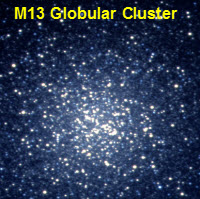 The most celebrated object in the constellation is the globular cluster M13, one of the best examples of such a cluster in northern skies. It is visible as a fuzzy star through binoculars, but is a fine sight through a telescope – which can be partly resolved in apertures of 6” and above giving an almost 3D impression.
The most celebrated object in the constellation is the globular cluster M13, one of the best examples of such a cluster in northern skies. It is visible as a fuzzy star through binoculars, but is a fine sight through a telescope – which can be partly resolved in apertures of 6” and above giving an almost 3D impression.
M13 resides around 26000 light years away and contains perhaps half a million stars. The other fine deep sky object is the globular cluster M92 – often overlooked, probably due to the relative proximity of M13. It should not be! It is a pleasing sight through a 6” scope or above.
Other fainter deep sky objects include NGC 6229 is a dimmer globular cluster, with a magnitude of 9.4, NGC 6210 is a planetary nebula of the 9th magnitude, 4000 light-years from Earth and visible as a very small blue-green elliptical disk in amateur telescopes larger than 4” in aperture. The constellation also contains the distant galaxy cluster Abell 2151 and the Hercules–Corona Borealis Great Wall, the largest structure in the universe.
The solar apex, i.e., the point on the sky which marks the direction that the Sun is moving in its orbit around the center of the Milky Way, is located within Hercules, close to Vega in neighbouring Lyra.
Events
 Observe the night sky with us at the Bruce Observatory, Whitby School
Observe the night sky with us at the Bruce Observatory, Whitby School
Observing Nights are held weather permitting: check for a relatively clear sky before leaving home. If in doubt, Mark can be reached on 07886069339
Please note the college drive gate is now operated via a electronic key code - so anyone wishing to attend must be at the car park at the top of the drive by 19:00hrs - unless an arrival time has been arranged with Mark/Keith.
 Observe the night sky with us at the Bruce Observatory, Whitby School
Observe the night sky with us at the Bruce Observatory, Whitby School
Observing Nights are held weather permitting: check for a relatively clear sky before leaving home. If in doubt, Mark can be reached on 07886069339
Please note the college drive gate is now operated via a electronic key code - so anyone wishing to attend must be at the car park at the top of the drive by 19:00hrs - unless an arrival time has been arranged with Mark/Keith.
 Whitby School - Room H1.
Whitby School - Room H1.
In Members' monthly meetings we usually take a tour of the night sky for the coming month using the Planetarium program. Have talks and presentations on various topics of astronomy/space etc, and discuss future events etc. New members welcome.
 Observe the night sky with us at the Bruce Observatory, Whitby School
Observe the night sky with us at the Bruce Observatory, Whitby School
Observing Nights are held weather permitting: check for a relatively clear sky before leaving home. If in doubt, Mark can be reached on 07886069339
Please note the college drive gate is now operated via a electronic key code - so anyone wishing to attend must be at the car park at the top of the drive by 19:00hrs - unless an arrival time has been arranged with Mark/Keith.
 Observe the night sky with us at the Bruce Observatory, Whitby School
Observe the night sky with us at the Bruce Observatory, Whitby School
Observing Nights are held weather permitting: check for a relatively clear sky before leaving home. If in doubt, Mark can be reached on 07886069339
Please note the college drive gate is now operated via a electronic key code - so anyone wishing to attend must be at the car park at the top of the drive by 19:00hrs - unless an arrival time has been arranged with Mark/Keith.

